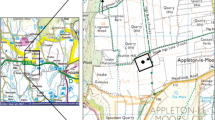Abstract
Azimuthal cross-square array resistivity soundings were used to detect fractures and investigate the anisotropic properties of crystalline basement rocks in some parts of Eruwa, southwestern Nigeria. Resistivity measurements were taken at ten locations using an Ohmega terrameter. The technique involves the rotation of the electrode array in four different azimuths, namely, 0°, 45°, 90°, and 135°, at electrode spacing of A(2)1/2. The measured apparent resistivity were used to calculate azimuthal resistivity, fracture strike, bedrock anisotropy, coefficient of anisotropy, secondary porosity, and azimuthal inhomogeneity ratio (AIR). The results showed that the measured apparent resistivity changed with the orientation of the array implying fracture anisotropy in the subsurface. The calculated azimuthal resistivity shows that values increase with electrode spacing with polar plots indicating varied fracture directions. Primary fractures in the study area are oriented dominantly in N-S, NW-SE, and E-W directions which contrast with NE-SW and E-W trends of their secondary counterparts. Few tertiary fractures are aligned in E-W direction. Coefficient of anisotropy (λ) ranges between 1.05 and 3.68, while bedrock anisotropy (N) varies from 1.002 to 2.483; calculated secondary porosity (fracture porosity) ranges from 0.07 to 0.99. The comparison of the fracture porosity and mean resistivity revealed four major fracture zones in the study area. Interpreted AIR (azimuthal resistivity ratio) values of −5.09 to 0.97 show that anisotropy inhomogeneity of the study area is low. This work therefore gives insight to anisotropic properties as well as the fracture characteristics in the study area.













Similar content being viewed by others
References
Ajibade OM, Ogungbesan GO, Afolabi OA, Adesomi T (2012) Anisotropic properties of fractures in parts of Ibadan, southwestern Nigeria using azimuthal resistivity survey (ARS). Res J Environ Earth Sci 4(4):390–396
Al Hagrey SA (1994) Electric study of fracture anisotropy at Falkenberg. Germany Geophys 59:881–888
Bayewu OO, Oloruntola MO, Mosuro GO, Folorunso IO, Kolawole, Ajibola U (2014) Evaluation of resistivity anisotropy of parts of Ijebu Igbo, southwestern Nigeria using azimuthal resistivity survey (ARS) method. J Geogr Geol 6(4):140–152
Beeson S, Jones CRC (1988) Hydrogeology of crystalline aquifer in northern Nigeria and geophysical technique use in their exploration. Nat Sci Eng Geol 66:155–82
Billings, M.P. (1972): Structural geology, 3rd Edition. Prentice-Hall
Busby, J.P. (2000): The effectiveness of azimuthal apparent resistivity measurements as method for determining fracture strike orientations. Geophysical Prospecting, 677–698
Carlson, D.A., Taylor, R.W., and Charkauer, D.A. (1996): Azimuthal electrical resistivity as a tool for determination of orientation of preferred hydraulic transmissivity for dolomite aquifer in south-eastern Wisconsin. SAGEEP 1996 meeting, Keystone, Colorado, USDA, Expanded Abstracts.
Darboux-Afouda R, Louis P (1989) Contribution des measures de l’anisotropic electriquela recherché des aquifers de fracture en milieu crystalline au Benin. Geophys Prospect 37:91–105
Edet, A.E. and Essien, N.U. (1994): Geotechnical characteristics of some western Nigeria. International association of engineering geology .pp. 91–99.
Ehirim CN, Essien EE (2009) Comparative investigation of offset Wenner, square and Schlumberger arrays in electrical anisotropy studies. Scientia Africa 8(2):53–60
George AM, Okiwelu AA, Obi DA (2010) DC-resistivity estimation of secondary porosity and anisotropy using azimuthal resistivity survey: a case study of parts of Oban Massif and Obudu Plateau, southeastern Nigeria. Res J Earth Sci 2(2):24–29
Habberjam GM, Watkins GE (1967) The use of a square configuration in resistivity prospecting. Geophys Prospect 15:221–235
Habberjam GM (1972) The effects of anisotropy on square array resistivity measurements. Geophys Prospect 23:249–266
Habberjam GM (1975) Apparent resistivity, anisotropy and strike measurements. Geophys Prospect 23:211–247
Habberjam GM (1979) Apparent resistivity observation and the use of square array techniques. In: Saxov, S and Flathe, H. (eds). Geoexplor MonogrSer 1(9):211–247
Lane JW Jr, Haeni FP, Watson WM (1995) Use of a square-array direct current resistivity method to detect fractures in crystalline bedrock in New Hampshire. Groundwater 33:476–485
Leonard-Mayer, P. (1984): A surface resistivity method for measuring hydrologic characteristics of jointed formations. U.S. Bureau of Mines. Report of Investigations 8901.
Malik S.B, Bhattacharya D.C and Nag S.K. (1983): Behaviour of fractures in hard rocks—a study by surface geology and radial VES method. Geoexploration. Vol 21.pp. 181–189
Matias MJS, Habberjam GM (1986) The effect of structure and anisotropy on resistivity measurements. Geophysics 51:964–971
Odeyemi IB, Malomo S, Okufarasin YA (1985) Remote sensing of rock fractures and groundwater development success in parts of south-western Nigeria. Nat Res Forum 9:311–315
Odoh BI (2010) Electro-hydraulic anisotropy of fractures in parts of Abakaliki, Ebonyi State, Nigeria using ARS method. Int Arch Appl Sci Technol 1(1):10–19
Okereke CS, Esu EO (1994) A study of some Nigerian carbonate rocks. Eng Geology 271–283
Olasehinde PI, Bayewu OO (2011) Evaluation of electrical resistivity anisotropy in geological mapping: a case study of Odo Ara, West Central Nigeria. Afr J Environ Sci Technol 5(7):553–566
Ramanujam, N., Nathakiri, K., and Anthony Ravidran, A. (2006): Azimuthal square array resistivity studies to infer active fault zones in the areas of known seismicity, Kottayam District, Kerala. J.Ind. Geophys. Union Vol. 10, No. 3, pp. 197–208
Ritzi RW, Andolsek RH (1992) Relation between anisotropic transmissivity and azimuthal resistivity survey in shallow fractured, carbonate flow systems. Groundwater 7:774–780
Senos Matias MJ (2002) Square array anisotropy measurements and resistivity sounding interpretation. J Appl Geophys 49:185–194
Skjernaa, L. and N.O. Jørgensen. (1993): Detection of localfracture systems by azimuthal resistivity surveys: examples from South Norway. Memoirs of the 24th Congress of International Association of Hydrogeologists. Pp: 662–671.
Slater LD, Wishart DN, Gates EA (2006) Self potential improves characterization of hydraulically-active fracture from azimuthal geoelectrical measurements. Geophys Res Lett 33:L17314
Taylor RW, Fleming AH (1988) Characterising jointed systems by azimuthal resistivity surveys. Groundwater 26:464–474
Watson KA, Barker RD (1999) Differentiating anisotropy and lateral effects using azimuthal resistivity offset Wenner soundings. Geophys 64(3):739–745
Author information
Authors and Affiliations
Corresponding author
Rights and permissions
About this article
Cite this article
Bayewu, O., Oloruntola, M.O., Mosuro, G.O. et al. Application of cross-square array and resistivity anisotropy for fracture detection in crystalline bedrock. Arab J Geosci 9, 291 (2016). https://doi.org/10.1007/s12517-016-2305-1
Received:
Accepted:
Published:
DOI: https://doi.org/10.1007/s12517-016-2305-1




